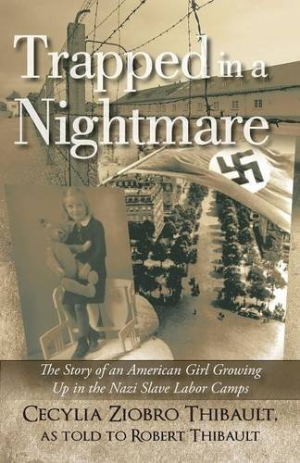Trapped in a Nightmare
The Story of an American Girl Growing up in the Nazi Slave Labor Camps
Trapped in a Nightmare transcends other self-published memoirs about people with power and their exploitation of the weak.
The words “Nazi atrocities” instantly evoke images of the extermination of European Jews during World War II. Trapped in a Nightmare, by Cecylia Ziobro Thibault, dramatically illustrates that Jews were not the only victims. Drawing upon memories of the Nazis’ capture of herself and her mother, Thibault paints a dismal picture of life as the child of a slave laborer, in detail as exquisitely rendered as it is exhausting.
Subsequent to the 1939 German invasion of Poland, Nazis arrested thousands of Polish citizens and transported them to work in slave labor camps. Among them was the author, then eight years old, who recounts her four years spent as a child slave. Told to Thibault’s son, Robert, this memoir is so heartbreaking that the reader will wonder at the author’s survival.
During the autumn of 1940, Nazi soldiers terrorized Thibault’s village, arrested its Christian residents, and took them to Germany to substitute for workers serving in Adolf Hitler’s army. Initially, Thibault and her mother were heartened when they arrived at a pleasant-looking village near Dresden. “What we didn’t know at that time,” she explains, “was that we were part of the notorious Buchenwald network of camps.”
Months of misery followed. With Thibault’s mother working long hours on the farm, the young girl was left alone to suffer a series of mishaps. Among those told of are accounts of hoisting herself up after falling into a deep well and German children locking her in a chicken coop or throwing her into a large pile of manure, after which she distrusted all “friendly” Germans. Gnawing hunger pains left Thibault scrounging for food beyond the grim diet accorded prisoners. She describes stealing from the nest of a laying hen, picking potatoes from the grooves of a tractor tire, and furtively stuffing cherries into her mouth while picking them for the farmer’s wife (who stood right beneath the tree).
Once she turned ten, the Nazis considered Thibault an adult, which, her weary mother explained, meant, “If you work, then you can eat.” That obliged the young girl to care for her newborn brother, assist the farmer’s wife in her household duties, and attend to the farm’s cows, chickens, geese, and ducks. Even after the Allies conquered Germany, Thibault’s nightmare continued in several displaced-persons camps. Today, the elderly author—a wife and mother living in Florida—explains why she finally put her anger aside. To do otherwise is to fall victim to hatred, which “can define who you are.”
Trapped in a Nightmare transcends other self-published memoirs about people with power and their exploitation of the weak, but the book suffers from a monotonous writing style. While Thibault’s word pictures are initially engaging, readers may wonder not only at the need for exquisitely retelling each detail but also about the story’s veracity, since those memories occurred more than sixty-five years ago.
Nevertheless, this well-designed book is a wake-up call—or, more precisely, a wake-up alarm—whose ringing tone pleads for humane treatment of all political prisoners.
Reviewed by
Nancy Rubin Stuart
Disclosure: This article is not an endorsement, but a review. The publisher of this book provided free copies of the book and paid a small fee to have their book reviewed by a professional reviewer. Foreword Reviews and Clarion Reviews make no guarantee that the publisher will receive a positive review. Foreword Magazine, Inc. is disclosing this in accordance with the Federal Trade Commission’s 16 CFR, Part 255.

